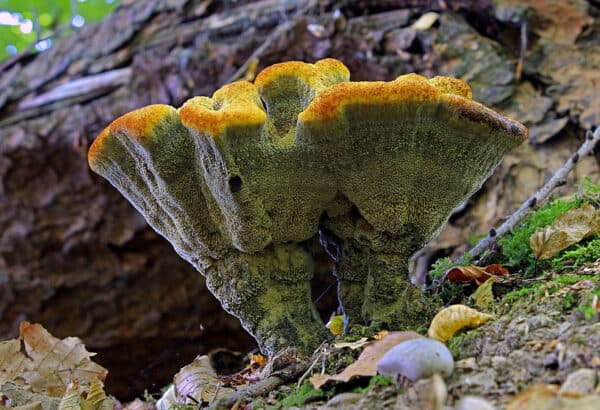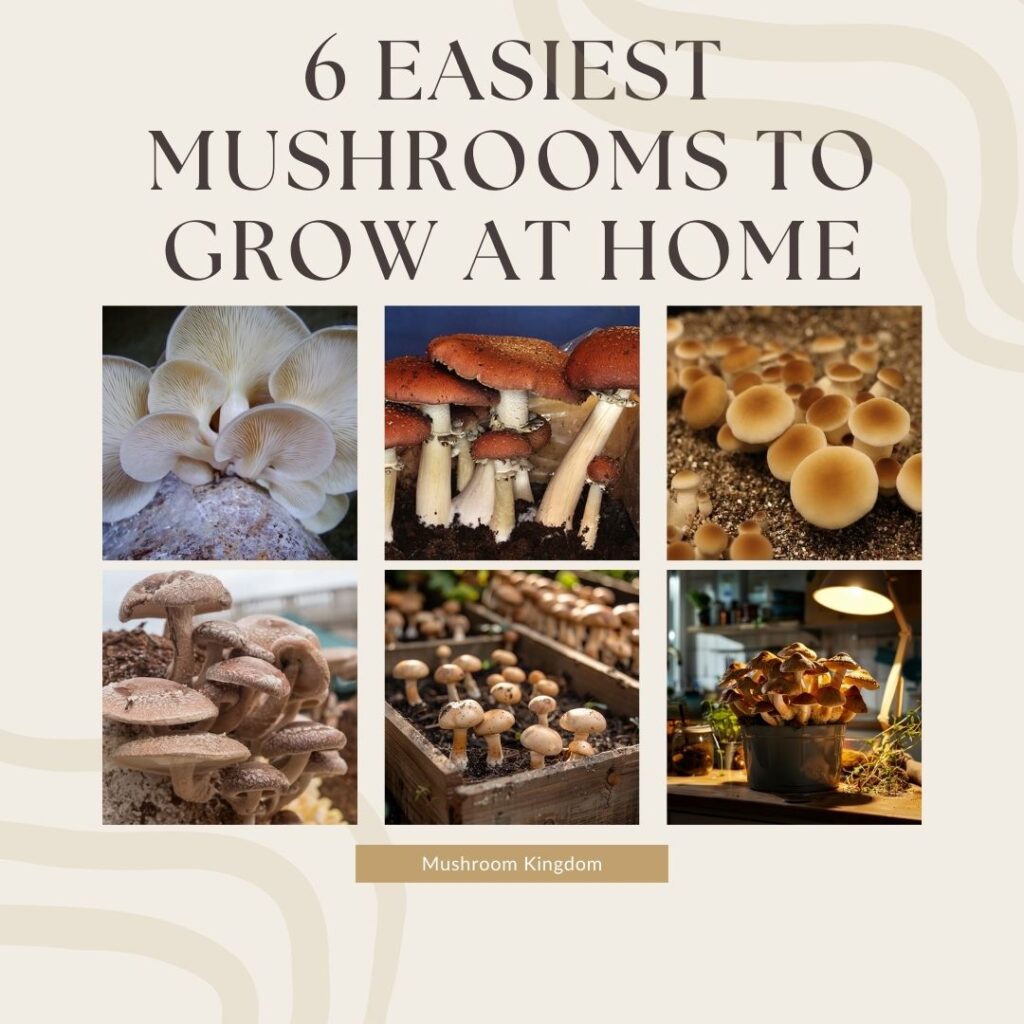Phaeolus schweinitzii, commonly known as the Dyer’s polypore, is a fungus found in coniferous forests worldwide, characterized by its velvety yellow to brown cap and tough, woody flesh.
It is prized for its use in natural dyeing due to the pigments it contains, but it is not edible due to its bitter taste and tough texture.
How To Identify Phaeolus Schweinitzii In The Wild?
Identifying Phaeolus schweinitzii, commonly known as Dyer’s polypore or velvet-top fungus, involves observing several key characteristics of the mushroom. Here are the steps and features to look for:

- Cap Appearance — The cap is typically irregular, circular to semicircular, and can be up to 30 cm (about 12 inches) in diameter. When young, the cap is bright yellow to orange-brown. As it matures, it darkens to a deep brown or greenish-brown. The cap surface is velvety to hairy, especially when young.
- Underside — The underside of the cap features tiny pores instead of gills. These pores are initially white to yellow and turn darker as the mushroom ages. The pore surface can bruise brown when handled.
- Stipe (Stem) — Phaeolus schweinitzii typically has a short, thick, and sometimes off-centred stem that attaches directly to the cap or can be absent with the cap attaching directly to the substrate. The stem, if present, shares the same velvety texture as the cap and is similarly coloured.
Where To Find Phaeolus Schweinitzii Mushroom?
Phaeolus schweinitzii is widely distributed across North America, particularly in the United States and Canada. It is also common throughout various parts of Europe, and can also be found in certain regions of Asia, including parts of Japan and Russia.
This fascinating fungi is primarily found in coniferous forests. It has a strong preference for growing in association with conifer trees such as pine (Pinus spp.), spruce (Picea spp.), fir (Abies spp.), and Douglas-fir (Pseudotsuga menziesii).
The fungus often grows at the base of living trees, on stumps, or on the roots of dead or dying trees. It can sometimes appear as a solitary fruiting body on the ground near the tree.
The fruiting bodies typically appear in late summer to fall. This period is when the environmental conditions, such as temperature and humidity, are optimal for the growth of the fungus.
Is Phaeolus Schweinitzii Edible?
Phaeolus Schweinitzii is not considered edible. The flesh is very tough and woody, making it difficult to chew and digest. It has a bitter taste, which is generally unpalatable. However, this fungi is not toxic.
Due to its tough texture and unappealing taste, it is not used in cooking or as a food source.
On the other side, it is valued for its use in natural dyeing. The mushroom contains pigments that can dye wool and other fibres in shades of yellow, green, and brown. This has been a traditional use among various cultures and continues to be of interest to natural dyers.
Compare With Similar Species
Several mushrooms can be mistaken for Phaeolus schweinitzii due to similar appearances, particularly in their early stages of growth or their overall morphology. Here are some common look-alikes:
Inonotus hispidus (Shaggy Polypore)
Inonotus hispidus has a similar brown and velvety cap, though it often has a more shaggy or fibrous surface. It is typically found on broadleaf trees like oak and apple, unlike Phaeolus schweinitzii which is associated with conifers.
Also, shaggy polypore usually grows in clusters or tiers, whereas Phaeolus schweinitzii often grows singly or in smaller groups.
Hapalopilus nidulans (Tender Nesting Polypore)
Hapalopilus nidulans has a similar orange to brown color, especially when young. The flesh is also spongy. You can find them on decaying hardwoods, particularly birch and oak.
It can be distinguished by the purple reaction when its flesh is exposed to potassium hydroxide (KOH), a feature not seen in Phaeolus schweinitzii.
Coltricia perennis (Tiger’s Eye)
This mushroom has a similar concentric zonation on the cap and a velvety surface. It grows in sandy soils, often among pine needles. It is usually smaller, has a central stem, and a more regular circular shape compared to the often irregular shape of Phaeolus schweinitzii.
Phaeolus schweinitzii (Dyer’s Mazegill) Etymology
The etymology of Phaeolus schweinitzii, commonly known as Dyer’s Mazegill, can be broken down into its genus and species names:
- Genus: Phaeolus
The name Phaeolus is derived from Greek roots. The prefix “phaeo-” (from “phaios”) means “dusky” or “brown,” and the suffix “-olus” is a diminutive form, indicating “small” or “lesser.” Thus, Phaeolus can be translated as “somewhat dusky” or “small brown,” likely referring to the color and appearance of the fungi in this genus.
- Species: schweinitzii
The species name schweinitzii honors Lewis David von Schweinitz, a prominent American mycologist of the early 19th century. Schweinitz made significant contributions to the field of mycology, and many fungi have been named in his honor.
Thus, the full name Phaeolus schweinitzii roughly translates to “the somewhat dusky fungus of Schweinitz.” The common name, Dyer’s Mazegill, refers to its traditional use in dyeing fabrics and the maze-like pattern of its gills.
Phaeolus schweinitzii (Dyer’s Mazegill) Facts
Phaeolus schweinitzii, commonly known as Dyer’s Mazegill, is a fascinating fungus with several interesting characteristics:
- Dye Production:
One of the most notable features of Phaeolus schweinitzii is its use in natural dyeing. It produces a range of colors, including yellows, golds, and browns, when used to dye wool and other fabrics. This property has made it a valuable resource for traditional and natural dyers.
- Parasitic and Saprobic Nature:
Phaeolus schweinitzii is both parasitic and saprobic. It initially infects living trees, particularly conifers like pines, spruces, and firs, causing brown cubical rot. As it progresses, it can kill its host and then continue to decompose the dead wood, recycling nutrients back into the ecosystem.
- Impact on Trees:
The fungus is a serious pathogen for trees, causing significant structural damage. It decays the heartwood of the tree, leading to weakened trunks and branches, which can result in breakage or toppling of the tree, especially during storms.
- Distinctive Appearance:
The fruiting bodies of Phaeolus schweinitzii are large, with a velvety, yellow to brownish upper surface and a maze-like pattern of pores underneath. They can grow in rosettes or tiered clusters on the ground near the base of infected trees or on stumps and logs.


